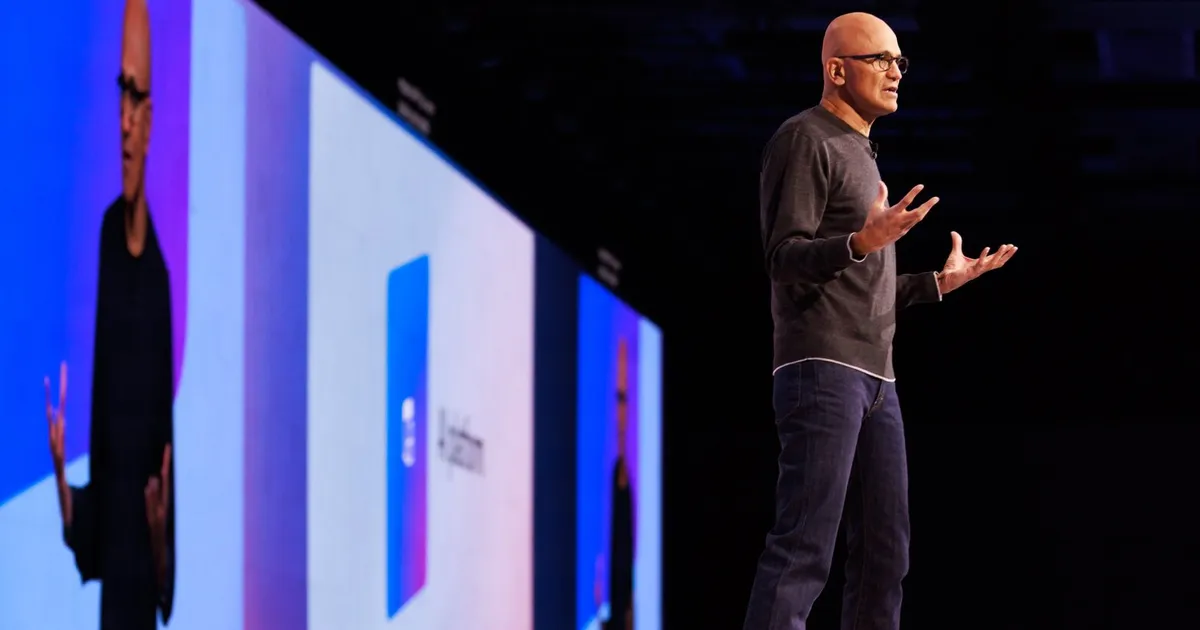In a three-month span filled with widespread layoffs and billions spent on AI, Microsoft made more than $27 billion.
The tech giant released financial results for its most recent fiscal quarter, which ran from May through the end of June, on Wednesday and exceeded Wall Street estimates. Microsoft reported $76.4 billion in revenue with $27.2 billion in profit, both metrics showing their highest year-over-year growth in over two years.
The company chalked up its superb growth to demand for artificial intelligence and cloud computing services.
“Cloud and AI is the driving force of business transformation across every industry and sector,” Microsoft CEO Satya Nadella said in a news release Wednesday.
For the first time Microsoft also broke out revenue for its cloud platform, Azure. Microsoft previously grouped Azure revenue with that of other products and services like Microsoft 365, which diluted comparisons with its rivals Amazon and Google parent company Alphabet.
Azure surpassed $75 billion in revenue during the fiscal year, which ended June 30, Nadella said. Amazon Web Services, Azure’s biggest rival, is projected to reach over $111 billion in revenue this year, Amazon said in March.
Microsoft revenue, profits jump with AI demand
AI and cloud computing fueled Microsoft’s highest quarterly revenue growth in over two years, the company said.
Microsoft expects more success for its 2026 fiscal year, which began July 1. Chief Financial Officer Amy Hood said Wednesday during a call with analysts that Microsoft expects double-digit growth in revenue again. The company reported 15% revenue growth during its 2025 fiscal year.
Behind Microsoft’s AI and cloud growth is an expanding infrastructure to support the demand. The company projected earlier this year that it was on pace to spend more than $80 billion on capital expenditures in its 2025 fiscal year, mostly in the form of data centers and pricey computer chips.
The estimate turned out to be conservative, despite spending in the third quarter that came in lower than expected. Hood said that capital expenditures reached $24.2 billion for the fourth quarter. That brings the year’s total to $88.2 billion, about $600 million more than in the previous two years combined.
Looking ahead to its 2026 fiscal year, capital expenditure growth is expected to moderate, according to Hood. But that leveling off will occur in later quarters, as Microsoft expects to spend an eye-popping $30 billion on its cloud and AI infrastructure by the end of September.
Microsoft’s rapid spending is putting pressure on its operating margins, despite its stunning financial results each quarter. Over the past few months, Microsoft trimmed costs by cutting jobs. The company’s leadership isn’t saying AI is driving job losses, but rather the high costs of investments are shifting Microsoft’s spending priorities.
The company’s financial results come a week after Nadella addressed layoffs amid the consistent run of record quarterly revenues and profits. Nadella acknowledged the “uncertainty and seeming incongruence” of the company’s job cuts.
During the quarter, the company laid off more than 6,300 employees. Microsoft laid off an additional 9,000 in early July, days after its new fiscal year began.
Microsoft is still hiring though. The company reported its head count as of June 30 was 228,000, flat from the year before.
But the makeup of the company’s workforce is changing, according to a regulatory filing from Wednesday. The number of roles categorized as product research and development dropped by 1,000 from last year, while operations roles rose by 3,000. Sales and administration jobs both fell by 1,000.
Microsoft also has 103,000 international employees, 1,000 more than last year. That increase coincides with a drop in U.S. employees from 126,000 to 125,000.
Microsoft’s financial success was evident across the board. Even segments that have struggled in the past like gaming grew their revenue.
Gaming revenue growth is coming primarily through content and services — the games Microsoft publishes and the subscription service Game Pass it markets to gamers. Nadella said the company has 500 million monthly active users across all gaming platforms and for the first time, Game Pass revenue reached almost $5 billion for the year.
That’s all helped by Microsoft’s acquisition of video game publisher Activision Blizzard, which owns the Call of Duty franchise. Microsoft has also shifted its strategy by offering its games on competitors’ devices, like Sony’s PlayStation and Nintendo’s Switch.
“We are now the top publisher on both Xbox and PlayStation this quarter,” Nadella said.
Over the next few months, Hood said Microsoft expects sales for gaming to decline.
Microsoft’s stock rose by 9% in after-hours trading and is currently valued at $3.81 trillion.
Microsoft Philanthropies underwrites some Seattle Times journalism projects.
